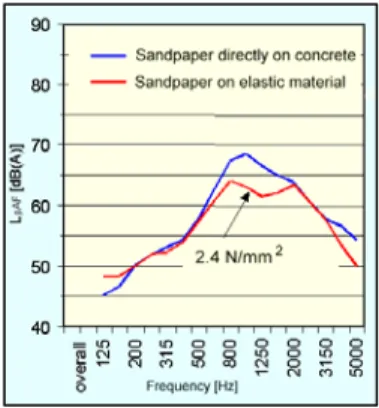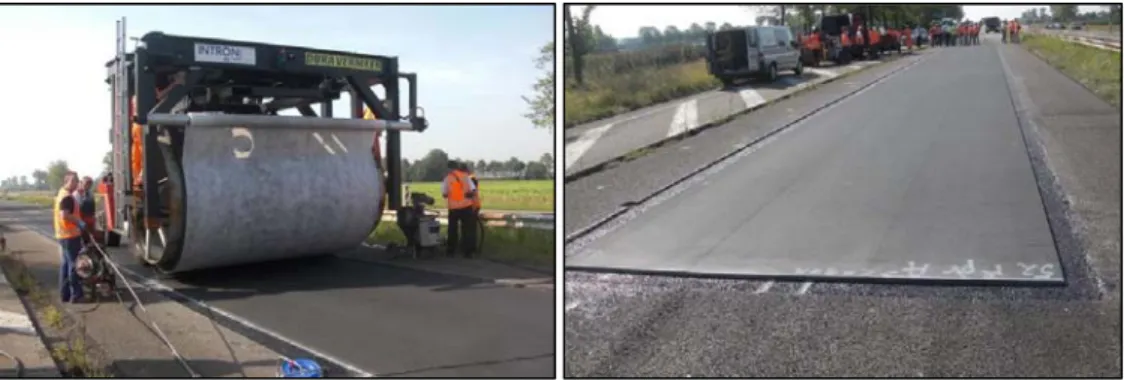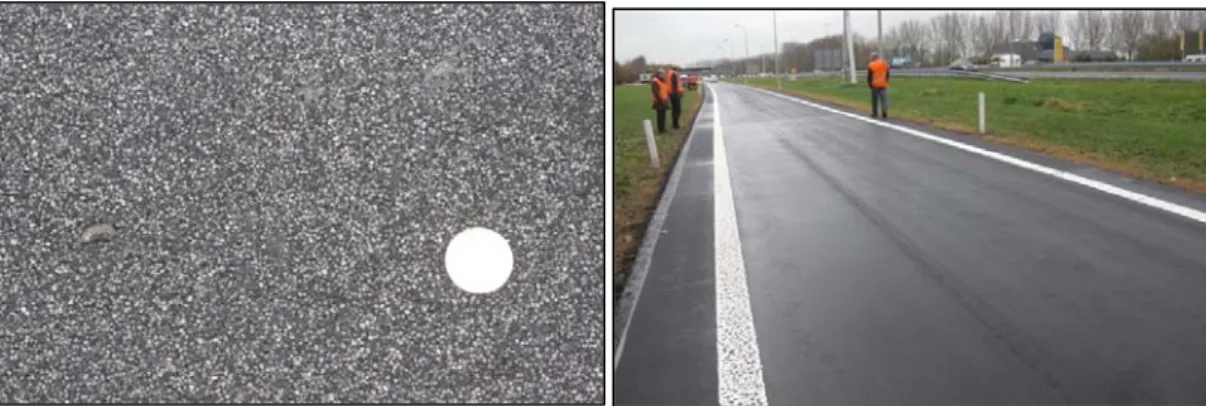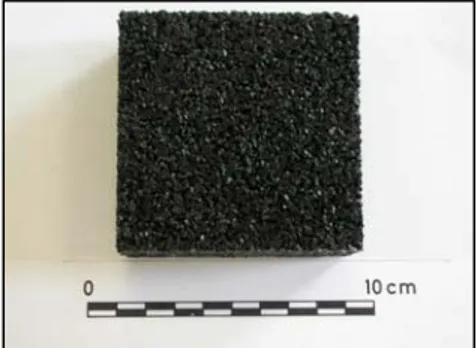The PERSUADE project: developing the concept of
poroelastic road surface into a powerful tool for abating
traffic noise
Luc Goubert1; Ulf Sandberg21
Belgian Road Research Centre; 2Swedish National Road and Transport Research Institute L.Goubert@BRRC.be; ulf.sandberg@vti.se
Abstract
Within the noise-abating action plans emanating from the European Noise Directive, there is much need for effective and efficient measures to abate traffic noise. In September 2009, the EC-funded project PERSUADE was started with a view to developing the concept of poroelastic road surface (PERS) into a durable, safe and environmentally friendly tool for extreme noise reduction. The main ingredients for PERS are recycled tyre granules and a polymer binder (generally polyurethane, not bitumen). The work will be carried out by a European consortium of twelve partners specialized in different fields and will be coordinated by the Belgian Road Research Centre. This contribution will discuss the state of the art for PERS and outline the working plan for the PERSUADE project.
Keywords: poroelastic road surface, PERS, noise abatement, rolling noise, tyre/road noise.
1 Introduction
This paper deals with PERS, which can be defined [1] as a wearing course for roads with a high content of interconnected voids and with an elastic behaviour due to the use of rubber as the main aggregate. The mixture for this wearing course is designed with an air voids content of at least 20 % and a rubber content of at least 20 % by mass. The binder is an elastic polymer, most often polyurethane. Mixtures with rubber granules, bitumen and coarse aggregate are generally referred to as asphalt rubber and are out of the scope of this paper and the PERSUADE project. In this paper, we will first discuss the principal mechanisms involved in generating and amplifying tyre/road noise. The role of the properties of the road surface will be explained, showing that the obvious way forward for substantial additional reduction of tyre/road noise is to make the road surface elastic. Then a historical overview will be presented for PERS. Experiments with various types of poroelastic road surface
(PERS), mainly in Sweden and Japan, have shown that large tyre/road noise reductions can be achieved; 10-12 dB(A) in comparison with dense asphalt concrete (DAC). This cannot be matched by far with conventional low-noise road surfaces – not even with the so far best performing types such as double-layer porous asphalt with 2/4 or 2/6 mm aggregates, which may provide at most 8 dB(A) of noise reduction. However, historical tests with PERS have all failed prematurely in one way or the other, mainly owing to problems with durability, adhesion and/or skid resistance. The very high noise reduction potential of the concept, nevertheless, justifies further research to convert PERS from a promising but still highly experimental concept into a usable noise-abating measure. The typical noise reduction achieved with PERS is comparable to that of noise barriers and the cost is likely to be very competitive if durability is enhanced. The EU-funded FP7 project PERSUADE (Poroelastic Road Surfaces to Avoid Damage to the Environment) aims at achieving this goal. The set-up of the PERSUADE project will be outlined in the final part of this contribution.
2 How can PERS reduce tyre/road noise by 10 dB or more?
The mechanisms contributing to tyre/road noise have been investigated since the 1970's. It has turned out that tyre/road noise results from a large number of interacting mechanisms [1]. The relative contributions of these mechanisms depend on road surface, tyres and driving conditions. The mechanisms can be classified in three main categories: vibrational (structure-borne), aerodynamic (airborne) and amplification/reduction mechanisms.
The main mechanism in the first category consists in “radial vibrations” (Figure 1) generated mainly by texture and tyre tread impact. To minimize this effect on conventional, “hard” road surfaces, irregularities with horizontal dimensions ("texture wavelengths") between 10 mm and (say) 200 mm (part of the macro- and megatexture ranges) must be avoided as much as possible. For that reason, small-sized aggregates are used for low-noise road surfaces. Nevertheless, tyre tread impacts cannot be avoided and there will always be some residual megatexture, which means that tyre vibrations cannot be completely suppressed.
Figure 1 – Radial tyre vibrations by impacts on road surface irregularities.
A second important mechanism, belonging to the mentioned 2nd category, is air pumping. When a tyre is running on a smooth surface, air is compressed at the leading edge of the tyre/road contact zone and is sucked-in at the rear edge (Figure 2). This can be avoided by providing the road surface with "deep" macrotexture or by making it porous, which will allow air to escape horizontally or vertically, respectively, thus reducing high pressure gradients.
The horn effect is an amplification effect caused by the multiple reflections of noise generated in the contact zone (e.g., by tyre vibrations) between the tyre tread and a reflective road surface (Figure 3). This effect can be suppressed by providing the road surface with accessible voids and making it sound-absorbing.
Figure 3 – Horn effect.
The reason why PERS can be such an extraordinary low-noise road surface is that it combines countermeasures against these three principal noise-generating mechanisms described above:
o Appropriately produced, PERS has a very smooth surface and is elastic. The elastic surface means that not only the tyre is deformed when it is in contact with the surface, as is the case on a hard surface, but that the elastic surface takes-up some of the deformation. The lower and more gradual deformation of the tyre in its leading and trailing edges means lower vibration excitation and that noise emitted by the tyre vibrations is much lower than on conventional hard road surfaces. This is a main reason for the exceptional acoustic properties of PERS.
Figure 4 shows the effect of an increase in elasticity of the road surface; texture being the same. A tyre/road noise spectrum was measured on a hard concrete surface covered with sand paper and on an elastic surface (rubber) covered with the same sand paper. The difference in the two tyre/road noise spectra shows a substantial effect of elasticity: a noise reduction in the frequency range between about 500 and 2,000 Hz. The noise reduction peaks at 1,000 Hz where it amounts to 5 dB.
o PERS has a high air void content, typically 30-40 %, whereas for conventional hard porous surfaces, void content is generally limited to 20-25 %, in rare cases up to 30 %, for durability/stability reasons. A higher void content accounts for more efficient suppression of air pumping (efficient evacuation of air through accessible voids) and the horn effect (sound absorption). Roadside noise is reduced by avoiding reflection from the road surface, which accounts for an additional noise reduction in comparison with impervious road surfaces such as DAC.
3 Historical perspective of PERS
13.1 Invention and early trials in Scandinavia (1979-1990)
The concept of PERS was invented in Sweden at the end of the 1970's by Mr. Nils-Åke Nilsson. Some limited laboratory and small-scale field experiments were carried out in Sweden during the 1980's, demonstrating the large potential of this new type of road surface for the reduction of tyre/road noise (7.5 – 12 dB(A)). Inspired by the Swedish experiments, a 130 m long test section of PERS was constructed on a street in Oslo early in 1989, but this experiment failed after the surface was destroyed accidentally by a snowplough in the late autumn of that same year. Noise reduction on the Norwegian test section was found to be 7 – 9 dB(A) for passenger cars.
3.2 Japan (1994 – present)
In 1994 the Japanese Public Works Research Institute (PWRI) initiated research in the field, building on the first Swedish results. A series of laboratory tests were carried out and a first test section laid with 1 m x 1 m prefabricated panels was built on the PWRI circular test track for durability testing in 1996. The Japanese found that adhesion was not very durable with DAC as a substrate but the cement concrete gave sufficient adhesion. Therefore, they have mostly used a semi-flexible surface instead (porous asphalt with the pores filled with cement), thus reducing the problems with adhesion. In the beginning elongated fibre-like particles were used, which were bound with 15 % of polyurethane. Three more types of PERS were laid in 1996 on the PWRI test facility, with 30, 35 and 40 % of voids. Cruising tests with a passenger car, a light and a heavy goods vehicle yielded noise reductions of 7 – 11 dB(A), 4 – 5 dB(A) and 3 – 5 dB (A), respectively.
As friction was too low on the first generation of Japanese PERS types, four new types (Figure 5) were developed with an acceptable initial skid resistance. Test sections with these new types of PERS were built on the PWRI test facility in 2000, complying well with Japanese friction standard (Figure 6).
In the period 2002-2005 full-scale experiments were carried out on Japanese highways. Eight different PERS types were tested on three locations. They all failed within a relative short time after construction (max. about 1 year) owing to ravelling, adhesion and friction problems.
1
Figure 5 – Four types of Japanese PERS with enhanced initial skid resistance.
Figure 6 – Skid resistance on the four types of Japanese PERS with enhanced skid resistance (RSO = Japanese friction limit and DENAP = DAC)
In the period 2005-2008 PWRI investigated how one may improve the durability of the skid resistance of PERS and tested three new PERS types with enhanced skid-resistance properties on a highway immediately outside PWRI in Tsukuba City. A new adhesion system, double-sided adhesive tape, was used, but the three sections failed within 1.5 year as a result of adhesion problems. Skid resistance remained OK during the short test period. The noise reduction was estimated to be around 6 dB(A), but the sections were far too short (5 m each) for proper noise testing.
Three new test sections were built early in 2009 on the PWRI circular test track and subjected to passages of unmanned, GPS-guided HGVs: a PERS constructed on site by Yokohama Rubber Company to a thickness of 30 mm, with approx. 50 % of rubber and 50 % of fine aggregate (2.5 – 3 mm) and a binder (details are company secret); and two sections with precast panels by Sumitomo Rubber Industries, one fixed with epoxy on a semi-flexible substrate and one fixed with adhesive tape on new asphalt. In February 2010, after exposure to some 500,000 HGV wheel passages, the sections were reported to still be in good condition.
The site-constructed Yokohama type tested on the PWRI circular test track has also been tested in a full-scale experiment on a city street in Zama City, plus new ongoing trials in Hiratsuka (Figure 7) and in Iizuka. The section in Zama City was constructed in December
2006 and the one in Hiratsuka in March 2009. Both test sections were in good condition when the author took the pictures of Figure 7 during a visit to the sites in April 2009. From Japanese data, noise reduction could be estimated to be about 10 dB(A) in comparison with new DAC 0/16. Details about composition were not revealed, but air void content would be about 30 % and silica sand with a maximum diameter of 5 mm was used, as well as rubber granules about 1 mm in size. The rubber/aggregate proportion is estimated to be about 40/60. While walking over it, the surface felt quite rigid, almost like plain asphalt. The binder is polyurethane and a polyurethane primer and tack coat were used. Skid resistance still complies with Japanese standards.
Figure 7 – Site-constructed Yokohama PERS types in Zama (left) and Hiratsuka (right).
The Zama City test section has, in the mean time, been removed after the contract period of three years had expired. Some problems with the binder course were observed when removing the PERS layer. This is investigated further.
3.3 Later Swedish experiments (2000 – 2005)
In the period 2000-2005, VTI could carry out a PERS project thanks to national funding (VINNOVA); later supplemented with European funding (SILVIA project) and some local support (City of Stockholm). Lots of laboratory tests were carried out, including wear tests in the VTI Road Simulator machine. The PERS turned out to be more wear-resistant than the reference SMA 0/16 pavement. It was also demonstrated that the use of PERS would not necessarily lead to an increase in rolling resistance. In the autumn of 2004 a full-scale test was carried out on a street in western Stockholm, comprising three test sections: a section with a PERS type called Spentab, which was a site-constructed type, and two types with precast tiles (1 m x 1 m); one by Tokai (Japanese product) and the other by Rosehill (British product). Figure 8 shows the test sections right after construction. The noise reductions found in comparison with the adjacent old DAC 0/11 ranged between 9 and 12 dB(A). Unfortunately, the experiment had to be aborted and the PERS layers removed only four months after construction, owing to a problem with a disintegrating base course.
Figure 8 – VTI tests in Stockholm with three types of PERS, right after construction in 2004.
3.4 Dutch experiments (2002 – present)
In the Netherlands awareness of the huge traffic noise problem led to the decision to carry out a "noise innovation programme" (IPG), which started in 2002 and ended in 2008. This national large-scale project aimed at developing effective tools for abating road and railway noise in an affordable way. Low-noise road surfaces2 were considered to play an important role as an abatement measure. As a “fourth generation” low-noise road surface, PERS was included only to a limited extent in the IPG programme. Six short test sections were built on a test track at Kloosterzande. The test track was not subject to traffic, but the results of CPX measurements were rather disappointing for the PERS sections, most probably owing to joints between panels. Poroelastic road surfaces were included in the Acoustic Optimization Tool (AOT), a sophisticated software package for tyre/road noise prediction developed under IPG. The further development of PERS is the subject of a follow-up project on “supersilent” road surfaces (SSW), which started in 2008 and will end in 2011. Within this project, a joint venture of Dutch road contractors Duravermeer and INTRON built a new 40 m long PERS section at Kloosterzande for Rijkswaterstaat in August 2009, using the experimental "Rollpave" technique (Figure 9). Thickness was 32 mm and the layer consisted of small rubber granules (0/1 mm) and small aggregates (0/1 mm), bound with polyurethane. The prefabricated roll was glued to the substrate with epoxy. Noise reduction measured by the CPX method was 7.9 dB(A).
Figure 9 – Construction of 40 m long PERS test section at Kloosterzande (Netherlands) using the Rollpave technique, by INTRON/Duravermeer funded by DWW.
2
Subsequently, in November 2009, a new 260 m long test section was built by the same technique on a service road along the A50 in Apeldoorn (Figure 10). No measurement results have been received so far by the authors.
Figure 10 – 260 m long PERS test section along motorway A50 near Apeldoorn (Netherlands) in the DWW project. The coin in the left-hand picture has a diameter of 24 mm.
4 The PERSUADE project
4.1 Goals
of
the
PERSUADE project
The project aims at developing a durable cost-effective PERS using recycled tyres. This would benefit the environment by not only significantly contributing to abating traffic noise and vibrations, but also helping to solve the problem of over three million tonnes of waste tyres to be dumped or burned every year in the twenty-seven EU Member States, with the consequent soil and air pollution. It is anticipated that advanced optimization of the poroelastic rubber compound could also lead to some decrease in rolling resistance for the vehicles travelling on such a pavement and, as a result, could contribute to reducing CO2 and
other emissions.
4.2 Strategy
4.2.1 General information
The general goal is to remove doubts about the technical and economical feasibility of the PERS solution for abating road traffic noise, by demonstrating its potential in successful full-scale applications. The project has been scheduled for a duration of six years and an overall budget of 4.7 million €. Twelve partners in eight countries are involved. The strategy comprises the following five steps.
4.2.2 Laboratory and small-scale testing
To maximize the chances of technical success, the following preliminary work is carried out: - Laboratory tests with a view to optimizing the mix design for mechanical properties (complex elastic modulus, flexural fatigue and hysteresis), acoustic properties (sound absorption), adhesion (to different substrate materials), workability, porosity/drainage, resistance to tear and wear, resistance to rutting, and oil and fuel resistance;
- Small-scale field experiments for testing resistance to emergency braking by heavy vehicles and for fire-resistant performance.
4.2.3 Production of PERS material
Once an optimum mix design has been chosen, the material will be produced by specialized partner factories in different forms for different laying/construction methods: delivery of batches of bulk material, application of PERS on paving blocks for urban streets, prefabrication of sheets or mats and laying in long stretches followed by rolling on a drum for subsequent transport and unrolling on site (Rollpave technique).
4.2.4 Time-staged construction of seven test sections in five countries
The conditioned material will be delivered to the five partner countries that will build test sections on real roads (Belgium, Denmark, Sweden, Poland and Slovenia) in order to study the behaviour of different variants of PERS under different traffic and climate conditions. The tested solutions will partly differ from country to country. The full-scale sections will be built in two stages, with the second following twelve months after the first. The aim of this time-staged approach is to be able to learn from the experience gained in the first stage when preparing the second.
4.2.5 Monitoring of the test sections
The test sections will then be monitored by initial and periodic measurements of tyre/road noise (SPB and/or CPX measurements), sound absorption, skid resistance, rolling resistance (to be converted into fuel consumption and greenhouse gas emissions), drainage (to test for possible clogging), and winter behaviour (deicing by salt, snow removal). As a result of the time-staged construction of the test sections, steps 4.2.4 and 4.2.5 will be partly simultaneous.
4.2.6 Evaluation of PERS technology
Finally, an overall evaluation of PERS technology will be made and disseminated, based on the technical results from the full-scale experiments, on cost-benefit analysis (CBA) and life cycle assessment (LCA), using the information gathered from the activities throughout the project This will include consideration of the waste management balance and the global greenhouse gas emission balance.
4.3 The PERSUADE consortium
The Consortium is formed by six national research institutes: BRRC (coordinator of the project, Belgium), VTI (Sweden), DRI (Denmark), ZAG (Slovenia), IBDiM (Poland) and LCPC (France); two universities: TU Gdansk (Poland) and KU Leuven (Belgium); and four industrial partners: NCC (contractor, Denmark), Duravermeer (contractor, the Netherlands), HET (SME specialized in manufacturing products with rubber granules and polymers, Germany) and ETRA (representing tyre recyclers, France).
Five of the national research institutes will build and monitor test sections with the support of their respective national or local road administrations.
4.4 Progress
so
far
o dissemination: a website has been constructed (http://www.persuadeproject.eu) and a comprehensive state-of-the-art report has been produced [3]. This report has a “public” status and can be downloaded free of charge from the project website;
o mix development: feasible test methods have been selected, moulds for samples have been manufactured and the first samples have been prepared.
o cost-benefit analysis (CBA), which has been initiated. PERS will be compared in a few typical case studies with other candidate noise-abating measures and the costs and benefits will be assessed.
Figure 11 – PERS test sample prepared for adhesion testing in the PERSUADE project.
4.5 Final
remarks
In view of the long series of historical attempts and subsequent failures, it cannot be denied that there is a risk that this research project will not be successful. Nevertheless, the “reward” in case of success would be very high, as a powerful alternative to noise barriers would become available for abating traffic noise. Noise barriers do have a lot of disadvantages: intrusiveness, vulnerability to vandalism, high cost, etc. The chances of success will be optimized in the PERSUADE project by a stepwise approach, an extensive laboratory programme, time-staged construction of the test sections, and the know-how available in the consortium as well as its “balanced” membership.
Acknowledgments
The PERSUADE project consortium gratefully acknowledges the financial support granted by the European Commission through its 7th Framework Programme (FP7) and the national support by the partners themselves or by various national sponsors.
References
[1] Sandberg, U.; Ejsmont, J.: Tyre/Road Noise Reference Book, Informex, Kisa (Sweden), 2002 (www.informex.info).
[2] Beckenbauer, T.: Akustische Eigenschaften von Fahrbahnoberflächen, Strasse+ Autobahn, Vol 54 (10) 2001, pp. 553-561
[3] Sandberg, U.; Goubert, L.; Biligiri, K.; Kalman, B.: State-of-the-Art regarding poroelastic road surfaces, Deliverable D8.1 of the PERSUADE project, downloadable from http://www.persuadeproject.eu (2010).






